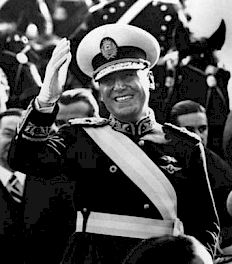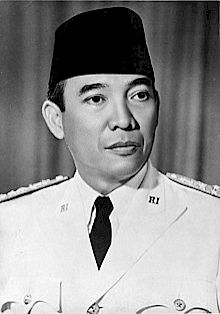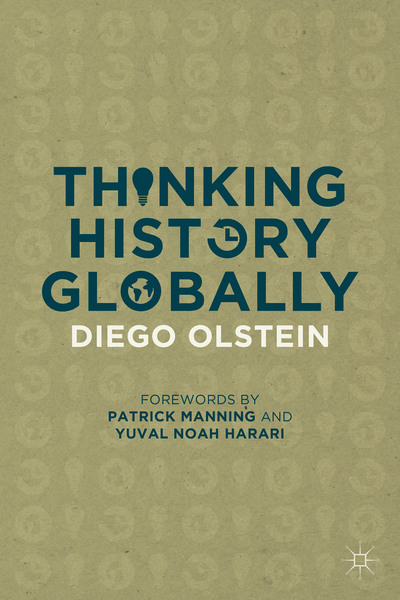A Global History Primer: Discussing "Thinking History Globally" with Diego Olstein
As you read this post in the summer of 2015, the discipline of history is decades into a global turn. Rare is the historian whose work does not aim, or at least claim, to transcend boundaries national, regional, or linguistic. The days of "methodological nationalism" appear to be behind us, then, but the specifics of how we do what comes next are not always clear. True, a booming literature guides us through the ins and outs of different approaches: world, global, trans-national histories; histories of familiar nationally-defined units as a "nation among nations," or histories that go beyond the chronological boundaries within which nations or linguistic communities have historically existed. But where is the professional historian–or, more commonly, the student–to go if she wants to grasp the full "menu"of possibilities that the global turn brings to historians as a whole? Until recently, teachers had few such resources.
"Thinking History Globally," the most recent book by recent TPF Global History Forum guest Diego Olstein (University of Pittsburgh)
Until recently, that is, thanks to a welcome recent book by the University of Pittsburgh's Diego Olstein, an Associate Professor in the Department since 2011 and the author of Thinking History Globally, published this spring by Palgrave MacMillan. In the book, Olstein, a specialist on medieval Spain and world history, outlines the many ways in which historians today compare, connect, conceptualize and contextualize their subjects beyond pre-existing boundaries of national communities, linguistic boundaries, or pre-defined regions. No mere encyclopedia of global history approaches–Olstein limits his bestiary to twelve kinds–Thinking History Globally also provides readers with applied examples of how these approaches and cognitive patterns might actually be applied to different subjects. More than an entertaining read, the book is thus of great use for the professor or TA confronted with the question of, for example, what it actually means to write the First World War "in a global context."
No mere bookworm, however, Olstein and his journey to the field at all remind us of the ways in which historians' lives and careers today are themselves the product of global networks and the trans-national receptions of historical experiences. In Olstein's case in particular, this means a journey through the worlds of the Jewish diaspora in authoritarian Argentina, the intellectual horizons offered by Israeli academia, the experiences of researching medieval Spain, and, finally, Olstein's current home, Pittsburgh. Let us follow Olstein's own global intellectual journey before diving into his most useful recent work, Thinking History Globally.
•
We start our conversation with Olstein's intellectual formation in authoritarian Argentina. A second-generation Argentine whose grandparents had immigrated to South America from Eastern Europe, Olstein developed a sense for history through his family's roots. While his grandparents had left shtetl and war behind, they retained a sense of Eastern Europe as a real place. The young Olstein was often entertained by their Yiddish-language folk songs, and noted the generational divide when he saw that their knowledge of comparable Spanish-language music was limited. In his own recollection, Olstein's interest in the lives of his grandparents was his first connection to a rich past. In an attempt to contextualize their lives, young Olstein took an interest in reading Jewish history. Soon enough, he realized that the history of this community unfolded for millennia embedded in multiple civilizations. That is how fascination with world history first emerged nurtured, for example, through the syndicated series Il était une fois l'homme ("Once Upon a Time … Man").
When it came to his secondary school history classes, Olstein noticed that "Once ancient history was over, the more we moved forward into time, the more the rest of the world disappeared and only Western Europe at first, the Americas later, and finally Argentina alone counted." The loss of the world perspective made him suspicious. His critical views were further strengthened as the official nationalistic narrative (la historia oficial) was becoming under attack in the wake of democratic transition. Under these circumstances, he was powerfully inspired by Eduardo Galeano's Las Venas Abiertas de América Latina (The Open Veins of Latin America). This book, a literary version of Dependency theory, offers an alternative to the official story precisely by connecting the fate of Argentina and Latin America as a whole to the rest of the world, particularly the Atlantic Basin. From there, the discovery of the world-system approach was a short step.

Soon after completing high school, Olstein immigrated to Israel, where he "began his journey from being a generalist to being an Iberianist." The key link here was Professor Benjamin Kedar, a medievalist whose interests nonetheless spanned widely. Courses with Kedar, initiated Olstein on inter-cultural encounters in the medieval Mediterranean Basin and comparative history. His dissertation, focused on the Mozarabs of Toledo–Arabized Christians who lived for almost four centuries under Muslim rule (Mozarab comes from the same root as "Arab," and means, roughly, "Arabized.") became Olstein's first book, La era mozárabe: los mozárabes de Toledo (siglos XII y XIII) en la historiografía, las fuentes y la historia (English: The Mozarab Era: The Mozarebs of Toledo [12th and 13th Century] in the Historiography, the Sources, and History), published with Ediciones Universidad de Salamanca in 2006. This book reconstructs the patterns of interaction between the Christian settlers from the north and the local Mozarabs–that is, Arabized Christians in the city and hinterland of post-Castilian conquest Toledo (1085). After a century of self-imposed segregation, by the 1180's a process of intermingling started evolving, reflected in the gradual demographic homogenization of the landscape, the growth of economic and neighboring relationships between communities, and the increasing rate of inter-community marriages. As a result of that, in time, the Arabized Christians progressively adopted the Romance language (medieval Spanish) at the expense of their Arab language, redefined their identity, and became assimilated into the new society during the 14th century. However, amidst its own assimilation, the Mozarab community was able to acculturate the northern Christians by providing them with part of their Arab and Muslim economic, legal, and notarial legacies.
Once Olstein joined the teaching staff of HU, he eagerly signed on to promote the study of world history in Jerusalem. In addition to teaching courses in world history, Olstein gathered together faculty from across the University's far-flung Departments and units in order to create a multi-perpectival world history survey. All the while, Olstein's reading in the field of the global turn kept expanding, but he nonetheless lacked a good primer with which to introduce students to the historiographic and methodological shift.
What to do? Throughout the 2000s, Olstein began working on a draft of the manuscript that eventually became Thinking History Globally: here as a visiting scholar at Boston University or the University of Wisconsin-Madison; there as a visiting scholar at Jacobs University and the University of Pittsburgh. Pitt in particular impressed him as a place for developing the ideas in the text. Not only was the American style of grouping many historians–whether of Iberia or Japan–under one Departmental roof naturally conducive towards discipline-bending conversations. More than that, Pittsburgh already had a World History Center, whose Director, Patrick Manning, had already conceptualized how to transcend nationally- or regionally-bound frameworks for writing history. Several rich conversations ensued, and, as fate would have it, following a year back at the Hebrew University of Jerusalem in 2010-11, Olstein returned to Pitt–this time as an Associate Professor and Associate Director of the World History Center. Having become acquainted with global approaches in part through his own life, Olstein found global history now sitting squarely at the center of his professional concerns.
Ensconced at Pitt with a rough draft of Thinking History Globally, Olstein found himself in the ideal ecotope to sharpen his thoughts and finish the manuscript. In the book–a self-consciously schematic overview of the possibilities for writing history on a big scale–Olstein outlines what he views as the twelve major approaches to global history writing today. Briefly, then, in Olstein's telling they are:
- Comparative history
- Relational histories
- New international history
- Trans-national history
- Oceanic history
- Historical sociology
- Civilizational analysis
- World-system approach
- Global history
- History of globalization
- World history
- Big history
Skeptical of the bullet-point list? Olstein is, too, and he stresses that his classification is not meant to be set in stone but aims to be of conceptual and pedagogical value. "The point," notes Olstein, "isn't some deep urge to classify. The point is to provide readers with a broad menu of the approaches that are out there, so they can weigh the merits and demerits of the different approaches. Just as importantly," he adds, "the twelve approaches also function as professional communities."
Helpfully, Thinking History Globally provides not just a neat table of the major societies and journals behind his twelve approaches–again, the basis for the intellectual communities that are what's actually important–but also a very useful bibliography that students and readers can use to delve into the secondary literature emblematic of one approach or another. Interested in trans-national history, for example? Turn to page 200 of the book, and you'll find a selection of historiographical pieces (e.g. Pierre-Yves Saunier's 2013 Transnational History) as well as a list of 20-plus selected publications emblematic of the field–Kathleen Lopez's Chinese Cubans: A Transnational History (UNC Press, 2013) or Sarah Snyder's Human Rights Activism and the End of the Cold War (Cambridge UP, 2011) the latter on the Helsinki Watch networks that played an important role in putting human rights on the negotiating tables of détente. Similarly rich lists are there for the other eleven approaches that Olstein outlines.

Finally, and perhaps most importantly, Thinking History Globally defines these twelve approaches, discusses the historical origins of them, and uses example subjects to illustrate the different points of view that different approaches can bring to the same subject. The book opens with a standard national case study: the story of the rise to power of Perón in Argentina (1946-1955). As soon as readers become familiarized with this compelling story, they run into twelve different accounts of it, each inspired by a different "trans-boundaries" historical approach. Concepts like world history, global history, trans-national history, and the like become clear through this opening exercise.
The subsequent seven chapters unpack the definitions of the twelve branches, fully illustrating their uses with examples ranging from the dawn of civilization to current globalization. For the sake of clarity and aiming to provide readers with a ready-made toolkit, all twelve branches are branded by four major strategies for thinking globally: comparisons, connections, conceptualizations, and contextualizations. By the time the readers became fully familiarized with these four strategies and the twelve historical branches that apply them, a second and final experimental thought unfolds. This time, it is the unfolding of a global development, the First World War, framed again in twelve different narratives exemplifying the twelve trans-boundaries approaches and providing a final rehearsal. Readers are encouraged not only to apply any of the twelve branches explained and applied, but also to combine between them into powerfully creative synergies.
Olstein is careful to underscore that Thinking History Globally is intended as more of a primer into the field than an intellectual history of, say, oceanic history or the world-systems approach. Such a book would be welcome, if it does not already exist–but if it is to be written, it's likely only after its future author gains a comprehensive introduction to the breadth of non-national approaches on offer in Thinking History Globally. Still, we ask Olstein what he thinks accounts for the ups and downs of the various approaches noted in the book. While he is quick to stress his identity as someone who is not a "methodological nationalist"–he merely wants to provide an overview of the various options–broadly, he suspects that the story of the emergence of various approaches is the story of shocks beyond the frontiers of the nation-state. "Every time that a major catastrophe or change happened, there was this sense: 'we have to look beyond the nation, we have to get beyond this romantic nationalist history model so popular in the nineteenth century.'"
In Olstein's reading, for example, the rise of comparative history happened after the world wars–that is, comparing one nation with another, often with an eye more closed to trans-national or sub-national actors than many would today–is one example of this phenomenon. Why was the German Wehrmacht so effective against what many thought to be the finest army in the world, that of the French, during the summer of 1940? (Comparisons between "the West" and "the rest" remind us of how appealing this approach can be to this day.).
But since the oil shocks of the 1970s and the end of the Cold War in the 1980s, there have been more attempts not to locate the nation-state in comparison, but rather to understand the sub-national or supranational forces that bound and challenge even superpowers–think terrorists, or the United Nations. Throughout these years, moreover, economic re-globalization made a trans-national optic ever more intuitive to scholars. And in the last ten years or so, notes Olstein, a growing societal interest in the power of science–whether thanks to genetics, big data, or the Internet–has emboldened scholars of Big History, who propose to expand the fair bounds of professional history writing back: way back into what we used to call "Prehistoric" time or even to the Big Bang. According to such work, the lifespan of the nation or the nation-state is so short as to be laughable; only by thinking across such big time scales and placing homo sapiens into a much bigger narrative can we understand the specificity of Richelieu or Louis XIII.
Again, however, the point, at least for the purposes of Olstein's book isn't to champion the one approach or the other. "This," he notes, "is the point of using the examples of Perón and the First World War." Thinking history globally isn't a zero-sum game, and if the history of the discipline is any guide, new international contexts and debates within the discipline are likely to demand new approaches. But only by knowing where we, as historians, are coming from, are we likely to formulate answers and approaches to write the books and articles that speak to our own global condition.
•
With Thinking History Globally just out, Olstein has embarked on his newest research project, a global history of what he calls the "anti-hegemonic party-state" during the short twentieth century. When it comes to classifying political regimes, he argues, scholars take an over-regionalized lens: we talk of "Populist" regimes in Latin America, Totalitarian regimes in Europe, One-Party States in Africa, Arab Socialist regimes in the Middle East, etc. In fact many of these regimes have much in common. What interests Olstein is conducting a study of political regimes during the twentieth century's decades of economic de-globalization–the 1920s to the 1950s, say–to compare and contextualize globally regimes like that of Lázaro Cardenas (Mexico), Juan Perón (Argentina), Gamal Abdal Nasser, or Sukarno (Indonesia).

What was it about the global economic climate that made a specific model of mass mobilization seem so viable to regimes around the world? Olstein's hope is to combine an interest in historical sociology with international political economy to answer this question, bringing up for discussion along the way the proper axes–typological, not regional–for conducting historical comparisons. "Nasser," he says, "is more similar to Cardenas in Mexico than he is to Sadat. How did these strategies emerge from the international climate?" Olstein's work on the project is just in its early phases, but once completed it promises to stand in the next generation of global historians' bibliography of emblematic works.
Along the way, Olstein draws inspiration not just from his former teachers, like Kedar, and his colleagues, like Manning. Asked what works of history he has been reading lately, or what books have inspired him in particular, he cites two titles. One, Yuval Harari's Sapiens: A Brief History of Humankind appeared earlier this year and is an attempt to account, on a big history scale, for the survival and rise to dominance of homo sapiens alone among several species of hominids, indeed among billions of other species on Earth. "You don't have to agree with everything in the book," says Olstein, "but it is a powerful thought provoking book."
The other work that Olstein cites as occupying prime nightstand real estate is similarly ambitious in scope: Christopher Chase-Dunn's Social Change: Globalization from the Stone Age to the Present, a textbook for undergraduate and graduate audiences. Bigness and an appetite for ambitious comparisons are again the watchwords: "It brings hunter-gatherers in dialogue with globalization," says Olstein of Social Change. "It draws on the world-system approach." Even as Olstein remains keenly aware of the multiple overlapping traditions of global history writing, the early influence and appeal of the world-systems approach reveals itself in his recommendations.
Granted, young historians interested in moving beyond the nation-state as a unit of analysis may adopt different–or wholly new–paradigms for writing their history from said world-systems approach. But if and when they do so, it's clear that Thinking History Globally will help them understand the roots, promises, pitfalls, and potential prospects of using one approach or the other. At a time when there is much talk about a global history approach in research, Olstein's book comes as a much-needed introductory and teaching resource likely to be of great use to teachers in the field. For that–and for his taking the time to participate in this round of the Global History Forum–we thank Diego Olstein and wish him the best of luck in his upcoming projects.
